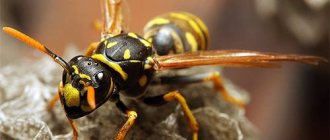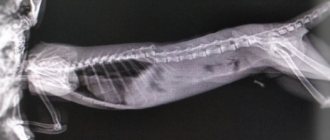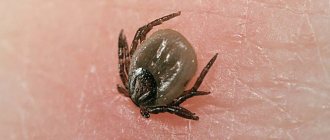The consequences of a wasp sting for kittens and allergy-prone pets can be tragic, even fatal. Therefore, in such a situation, you need to provide first aid to the animal as soon as possible. In addition, in some cases you cannot do without a veterinarian.
Let's find out what parts of a cat's body bites can lead to death and what needs to be done to save the pet.
What danger do wasp stings pose?
Most often, wasps bite on the paw pads or mouth area, much less often on other parts of the body, since the body of the animal is protected by fur.
If the bite occurs on the paw or body, then it will not pose a danger to the health of the animal. Pain and other unpleasant symptoms will go away on their own within 3-4 hours, leaving no consequences, except, perhaps, scars. However, in some cases, the owner of the animal may not notice that the cat has been attacked by a stinging insect.
Under no circumstances should you ignore the fact that a cat was bitten by a wasp. If this happened for the first time, then it is unknown how the animal’s body will react to the bite. The owner must pay special attention to the condition of the pet in cases where:
- The bite occurred in the area of the muzzle, head, throat, ears, nose, and lip. This is fraught with the possibility of swelling, which will spread to the respiratory tract. The likelihood of death from suffocation in this case is very high.
- The insect stings the genitals or groin - this can lead to blockage of the urinary tract.
- A wasp bites a cat in the eye - suppuration, inflammation, and even possible blindness develop.
- A wasp or bee bit a small kitten. Even a small dose of a toxic substance is enough to cause intoxication in a fragile body, which, in turn, can lead to the death of the baby.
- The animal has hypersensitivity and allergies.
Any of these factors can contribute to angioedema or anaphylactic shock, which is why it is so important to provide first aid to your pet in a timely manner, and if possible, immediately take the animal to a veterinary clinic.
Persians, British, and Angora cats are most prone to allergic reactions. There is also a huge danger for cats that have received multiple bee and wasp stings, as well as for animals with chronic diseases or who have recently undergone surgery.
Frequent bite sites
Most often, wasps bite cats on the limbs, because the animals hunt for insects and often crush them with their paws. Other common places where insects sting pets are in the head area:
- nose;
- lip;
- cheek;
- chin;
- eyelid;
- mouth
The greatest danger is caused by wasp stings in the muzzle area. If the poison gets into the tongue, lip or nose, the risk of swelling of the laryngeal tissue increases. In this case, the source of inflammation is immediately noticeable - a painful lump appears on the face. Some cats' entire heads become enlarged.
Sometimes wasps sting cats on the tongue. This happens if a pet tries to eat prey. Bites in the mouth can result in the death of the animal (due to swelling of the throat and trachea). Therefore, it is very important to examine the inside of the mouth and cheeks. The owner of the animal should be alert to increased salivation, the inability to close the mouth, noisy breathing with whistling or wheezing.
A bite to the eye will manifest itself as an increase in the volume of the eyelid and a narrowing of the palpebral fissure. Swelling can spread to the frontal part of the head, cheekbones and underarms. This often leads to the development of conjunctivitis and other serious consequences.
If the paw pads become red and very swollen, the cat may have been bitten on the paw by a wasp. A stung pet will not be able to step on it, but will limp or drag its leg behind it.
If the animal is not prone to allergic reactions, a bite on the paw will not lead to dangerous consequences.
In rare cases, wasps sting cats in the abdomen and groin area. For example, when a pet lies down on the grass on which an insect is sitting. Bees rarely bite cats on other parts of the body - hips, shoulders, back or neck.
Symptoms and complications depending on the location of the bite
Different parts of the body may experience different symptoms. So, if the bite was on the paws, then it can be detected by the animal’s limp.
Nose
A bite in this place is easy to detect, since the nose of the mustachioed-striped one instantly turns red and swells. If detected, it is better to immediately begin therapy with antihistamines. If help is not provided on time, at best the animal will have difficulty eating. At worst, swelling can spread to the nasal mucosa and cause suffocation.
Lip
When bitten on the lips, the cat's face swells, making its features disproportionate. The lip protrudes, the animal tries to press its muzzle to the ground in an attempt to get rid of the sting.
Cheeks
Stung cheeks become very swollen. The swelling may spread to other parts of the face or neck. With a strong reaction, the cat’s coordination of movements is impaired.
Language
When this organ is damaged, the cat develops shortness of breath, vomiting, and increased salivation. Help must be provided immediately to prevent swelling of the nasopharynx.
Eyelids and eyes
Bites to the area around the eyes can lead to serious complications, including loss of vision. An allergic reaction is manifested by swelling and inflammation.
Groin area
In this case, severe swelling is observed in the area of the urinary organs. If help is not provided in time, the swelling will block the ducts, and the animal may die from bladder overflow.
Which parts of a cat's body are most susceptible to wasp stings?
If your cat is restless and itchy, you should examine his body for insect bites..
- Wasps often sting the front paw pads, nose and mouth area.
- Much less commonly, a wasp sting can occur on the nose or lower part of the paw.
Very rarely, other parts of the body are attacked by wasps. This is due to the fact that the wasp inflicts chaotic attacks quite rarely, more often if the cat does not retreat. It is also almost impossible for wasps to get through the thick fur of a cat, so the muzzle and paws are the most easily accessible parts of the body. The exception is hairless breeds.
© shutterstock
A wasp sting for a cat is a signal that one should immediately leave the place of conflict, therefore multiple bites are possible only if the animal, due to inexperience, has ravaged the wasp hive.
How to tell if a cat has been bitten by a wasp
Due to the thick fur, a wasp bite on a cat’s body is quite difficult to detect. If the owner was nearby during the insect attack, he will notice the pet's strange behavior. The cat will jump sharply to the side due to severe pain, begin to meow loudly and behave aggressively - hissing, scratching or biting.
Lameness is a sign that the sting has gotten into the paw. If a wasp stings a cat in the face, redness and swelling will appear almost immediately. In any case, cats that have been bitten do not behave as usual. The animal does not allow itself to be examined, it breaks out and licks the sore spot if it can reach it.
First reaction
First, redness appears at the site of the wasp or bee sting. The pet experiences itching and pain, like after a burn. Swelling gradually appears at the site of the bite. Sometimes it is small and resembles a lump the size of a nut. In some cases, the surrounding tissues greatly increase in size.
The stung animal tries to scratch, lick or even chew the affected area. To relieve pain, the cat presses against a cool surface - the ground, the floor.
Symptoms that appear over time
Some time after a wasp sting, your cat may show signs of an allergic reaction:
- hives;
- increased salivation;
- increased body temperature;
- difficulty breathing, wheezing or gurgling sounds;
- convulsions;
- loss of consciousness.
Signs of anaphylactic shock
Persians, Britons and Angora cats are prone to allergic reactions, so they are at increased risk if they are stung by a wasp. They can quickly experience anaphylactic shock and death. An attack by stinging insects is also dangerous under the following conditions:
- age up to 6 months;
- recently had an infectious disease or surgery;
- presence of chronic diseases;
- gender – in males, allergies occur more often than in females, and are more severe;
- A hypersensitivity reaction to insect venom had previously been observed.
Attention! Multiple wasp stings are more dangerous than single ones, especially for a kitten. In this case, more toxic substances enter the blood, therefore increasing the risk of developing a severe reaction.
Pain and itching after a bite are not life-threatening for the cat. The discomfort will go away in a few hours. The real threat is anaphylactic shock.
It manifests itself:
- lethargy, inhibited reactions;
- blanching of the mucous membranes;
- chills, increased heart rate;
- wheezing;
- weak and frequent pulse;
- vomiting;
- involuntary urination.
Attention! In most cases, anaphylaxis develops rapidly – a few minutes after a cat is bitten by a wasp or bee. In some animals, the reaction may take several hours to appear. It is very important to carefully monitor the cat's condition so that if signs of anaphylactic shock occur, help can be provided quickly.
Bee sting treatment
If the sting is still in your pet's skin, it must be removed immediately. Venom from the sting can enter the pet’s blood within three minutes after the bite. Use the sharp edge of a credit card to remove the sting. You can remove the sting with tweezers or your fingers, but then you risk damaging the venom sac, which will enter the bloodstream.
Why is a bee sting dangerous for cats?
Dangerous places for bee infestation in cats:
- nose;
- larynx;
- groin;
- eyes.
Important! After a bee sting, swelling develops, the consequences of which can be blindness, suffocation, difficulty urinating, which can lead to disability or death of the animal.
How does an allergy to bee stings manifest in cats?
Allergies in cats to bee stings occur with varying degrees of severity. In total, there are 3 types of allergic reactions based on intensity:
- A moderate reaction causes lethargy, the temperature rises, and the cat refuses food. At this stage, no treatment is required; the animal’s body will cope with the bee venom on its own.
- The average degree is manifested by swelling at the site of the lesion, blisters appear, the skin around the eyes and neck swells, unbearable itching (urticaria) appears, which can become acute and threatens the life of the animal.
- Anaphylactic shock is a severe reaction to an insect bite that develops within a few minutes and threatens the death of the cat. In this case, urgent veterinary care and intravenous administration of antihistamines are necessary.
What not to do
It is important not only to help your pet correctly and promptly when bitten by stinging insects, but also not to cause harm. A cat was bitten by a wasp - what not to do:
- treat bite sites with any irritating ointments and gels for people containing menthol and essential oils;
- give any antiallergic drugs to people - at best they simply will not help, at worst they will harm the general condition;
- try to provide independent assistance for anaphylactic shock and Quincke's edema.
When do you urgently need specialist help?
Such cases include situations when:
- The sting of an angry wasp hit your pet's head or throat. The appearance of edema in this case threatens to block the airways and can lead to suffocation.
- The eye is damaged, which is fraught with suppuration, the development of an inflammatory process with subsequent complications.
- A very small kitten suffered from a bite. The smaller the animal, the stronger the effect of the poison on its body and the result can be serious intoxication.
- The animal is highly sensitive to substances contained in insect venom.
But still, bites on the neck remain the most dangerous. And if this happens to your beloved kitten, then take him to the vet immediately.
Swelling in the airway area is dangerous because it can cause suffocation
And remember that the most vulnerable to poison are:
- Muzzle
- Language
- Neck
- Eyes
- Groin.
If the animal is stung in one of the listed places, then you need to quickly seek help from the clinic. After all, severe swelling in the neck will make breathing difficult and can lead to suffocation.
Damage to the eye can lead to blindness, and swelling in the groin can compress the urinary ducts. And if measures are not taken in time, this will lead to unpleasant consequences.
Cats of long-haired breeds are prone to allergies: Persians, British, Angoras. In addition, their bite is not immediately noticeable.
Can cats have allergic reactions to bee and wasp stings?
Cats stung by bees or wasps can develop severe and life-threatening reactions if they are allergic to the insect venom. This reaction is most often seen in cats that have been stung previously. This is the result of the cat becoming “sensitized” to the bite and the immune system overreacting the second time around. Anaphylaxis is an emergency and can be fatal if your cat does not receive prompt veterinary treatment, which usually includes supplemental oxygen, an IV, and medications such as epinephrine, steroids, and antihistamines.
First aid for a pet
Complications after bites sometimes appear so quickly that there is simply no time to go to a specialist. In such a situation, the owner must be able to provide first aid himself.
To do this, you can use the following reminder:
- Wash the wound with soap and water to prevent possible infection.
- Wipe the bite area with table vinegar diluted in water in a ratio of one to one. This will help relieve pain and relieve itching.
- Add ice cubes. Exposure to cold inhibits the inflammatory process and reduces swelling.
If the wound is on one of the limbs, then you can limit yourself to a cold compress on it.
What not to do
When helping a cat after a wasp sting, it is important not to harm it. What not to do:
- apply a cloth moistened with dirty water from a pond or reservoir to the wound;
- lubricate the bite site with irritating ointments that contain essential oils or menthol;
- independently resuscitate your pet if there are symptoms of anaphylaxis;
- giving your cat pills intended for humans without your veterinarian's permission;
- You should not allow your cat to scratch the lump; you may have to wear a protective collar.
Options for helping your pet at home
Diarrhea and vomiting in a cat: what to do at home
Where to give intramuscular injections to a cat
If the above symptoms are detected, experts strongly advise contacting a veterinarian as soon as possible. But, since many owners first of all turn to the Internet for advice, several recommendations should be given.
- First of all, you need to determine the location of the bite. You won’t be able to cope on your own, since the animal at this moment is not in the mood for contact, so someone will have to hold the cat by force, and someone will have to check the fur centimeter by centimeter.
- Having found a place, armed with a manicure set, you need to remove the sting (if it was a bee) from the skin. This will reduce the amount of poison and may not lead to anaphylactic shock. The bite site should be treated with peroxide.
But further actions will be problematic if everything happened far from civilization and no one has a veterinary first aid kit lying around. If your cat does not tolerate the bite well, she needs an anti-inflammatory drug. In this case, the best options would be Prednisolone or Dexamethasone. It’s good if the medicine comes in the form of injections. Because feeding the tablet to an animal that has increased salivation and violence will be problematic. In addition, the injection works much faster.
The injections must be repeated for three days at intervals of 12 hours. In addition, cats will still experience itching, which they will scratch with their claws. Therefore, the wound must be constantly treated. Ideally, it would be good to limit the animal’s access to the affected area of the body by bandaging. At the same time, you need to understand that such bandages on the cats’ bodies do not last long.
Separately, it is worth mentioning the drug Benadryl, which has “pulled countless cats and kittens out of the dead.” This is an antiallergic drug that will help the animal not to suffocate and will get the cat back on its feet within 24 hours. It should be available always and everywhere, even if the owner is not sure of his pet’s allergic reactions.
First aid
It is important to know what to do and how to act promptly, what medications to use if your cat is suddenly bitten by a bee.
The first step is to remove the sting, which could remain under the skin and continues to exude pathogenic poison. When a wasp stings, it is gone.
- The cat or cat needs to be taken from the street, provided with coolness and complete peace.
- The bee's sting must be removed carefully using tweezers so as not to damage its integrity. You need to act carefully, otherwise the end of the poisoned needle will remain under the pet's skin and further surgical intervention may be necessary. After removing the bee tip, you need to press on both sides of the hole with your fingers - blood will come out of it, and along with it the remaining poison should come out.
- Next, the problem area of the cat’s body is treated with an antiseptic to remove inflammation. This can be a pharmaceutical cream, drug, ointment or folk remedies.
- To make the swollen part go away faster, use a cold compress.
When to go to the vet
Answering the question - when should you go to the veterinarian, the only correct answer will be - always. The animal’s body requires a special approach, and when a cat is stung by a wasp, you need to go to the veterinary clinic as quickly as possible, because the procedures described above cannot guarantee that everything will be fine with the pet. In addition, the drugs listed may have their own side effects, not to mention that not everyone has the knowledge and courage to give their cat an injection.
Urinary incontinence in a cat: what to do at home
It is clear that visiting a veterinary clinic becomes mandatory when the bites are numerous, for example, when a cat is attacked by a flock of bees or wasps. Also, you shouldn’t waste your time if the cat is very young or still a kitten. The younger the animal, the more sensitive to poison.
Important! If you delay contacting a doctor, the animal may develop kidney failure due to the poison, and then saving the cat will be much more difficult and expensive.
Some situations will require full hospitalization. In the event of a strong reaction or a situation neglected by the owner, the veterinarian will have to install an incubation tube for the animal to feed its lungs with oxygen, while simultaneously injecting saline solution mixed with adrenaline to stop the attack. After this, the animal is given a Prednisolone drip, which will ease the bronchospasm.
After eliminating the allergic reaction, cats are usually left for a day under medical supervision.
What to do - first aid
A cat that has been injured on the street should be immediately brought into the house and placed in a cool place, ensuring complete rest. In such conditions, the cat will come to its senses faster.
First of all, you need to know that the wasp does not leave its sting at the site of the bite. It’s another matter if the cat was bitten by a bee or stung by a bumblebee, which leaves a sting in the wound, so it must be removed with tweezers. This must be done with the utmost care so as not to crush the sting, otherwise even more poison will enter the body.
If a cat has been bitten by a wasp, first of all you need to apply a cold or ice compress to the sore spot, which will help relieve swelling and eliminate itching. Ice should first be wrapped in a clean towel or plastic bag. A soda compress also helps in such cases: baking soda is pre-dissolved in boiled water. When carrying out these manipulations, you need to talk kindly to your pet; at this moment, more than ever, he needs the care and support of a loving person.
What to do if a cat is bitten by a bee or wasp? You can wipe the area with a solution of 9% vinegar diluted with water in a 1:1 ratio, or with a soap solution. The procedure should be carried out regularly.
Often, owners use the homeopathic drug Apis (give 2-3 tablets, they will remove the danger threatening the pet). It is advisable to always have this remedy on hand, especially if the cat, having been bitten by a wasp, has already suffered from an allergic reaction previously.
If the cat was bitten by a wasp on the paw or body, and the animal’s condition has not worsened, these actions will be quite sufficient.
INTERESTING TO FIND OUT: What happens if you give a cat valerian?
Giving your pet medications to relieve allergic symptoms without consulting a veterinarian is extremely risky, since it is unknown what the body’s reaction will be. It may also happen that if used incorrectly, they suppress the immune system and lead to a secondary viral, bacterial or fungal infection.
Even if it is not possible to take your cat to a hospital, you can get the necessary information by phone.
As a rule, experts recommend Prednisolone, Dexamethasone, Benadryl (not contraindicated even for kittens), and Diazolin for cats. Suprastin is not prescribed so often - it is not such a universal drug, sometimes it causes an immune response in animals.
Under no circumstances should you inject your pet with adrenaline yourself; the procedure can only be carried out by a veterinarian!
Folk remedies for bites
Given the poor infrastructure in many remote areas, the above services and medications may not be available to many owners. Indeed, not every city has a veterinary clinic, and interruptions in the supply of medicines can also be seasonal.
As usual, traditional medicine comes to the rescue in such situations. It must be remembered that this is the most extreme measure when it is not possible to carry out normal treatment, because the effectiveness of the action and the recovery period for the pet will be completely different.
So, the main thing in this matter is to start stopping the bite from the very first minutes. You need to find the swelling/site of the lesion, take a lemon, orange or any other citrus fruit and apply it to the bite site.
Next, an infusion of chamomile or calendula is brewed and compresses are given to the animal throughout the day. This will partially help relieve inflammation. Turmeric powder, which needs to be diluted with water, will help cope with subsequent itching.
Important! Traditional medicine can only help if the animal does not have an allergic reaction.
Symptoms of a wasp sting in a cat
In some long-haired breeds (Persian, Angora, etc.), swelling may not be visible due to long hair. Trouble can be suspected by a change in the pet's behavior - it becomes angry, aggressive, does not allow the person who wants to examine it to approach it, and meows pitifully.
INTERESTING TO KNOW: How to stop cats from shitting in the entrance
In addition to the pain and itching that are characteristic of a stinging insect bite, the owner should be alert to the following symptoms indicating an allergic reaction:
- swelling in a certain place, edema;
- shortness of breath, difficulty breathing;
- vomiting (in some cases);
- increased salivation;
- hyperthermia;
- cardiopalmus;
- chills;
- movement coordination disorder;
- shock;
- loss of consciousness;
- convulsions.
If a wasp sting is suspected and the condition of a cat or dog worsens, the owner should take immediate action.
How to give a cat an injection yourself
As described above, in many cases the owner will have to give the cat an intramuscular injection himself. For many, it is a big problem to give an injection to a person, not to mention an unconscious animal. However, this must be done, and how to do this will be described below.
It all starts with choosing a syringe. For injections, you can use regular syringes, which are sold at the pharmacy. Since the dosage of drugs is usually limited to one standard ampoule, there is no point in taking a 10 cc syringe. A standard 2cc is best. If the injection is to be given to a kitten, then you can limit yourself to insulin. These syringes have the thinnest needles and the injection will be less painful.
Anyone can handle putting medicine into a syringe. It is important that there is no air in the syringe. After dialing, you can lightly press the plunger so that the medicine enters the needle and all the air comes out.
Next, you need to involve all your household or neighbors. It is advisable to wear thick clothing, as the animal is irritated and will protect its integrity.
The pet must be secured so that the middle of the thigh is open for the injection. You can pour alcohol over the injection site. Next, insert the needle. You don’t have to worry too much about the depth - 5-10 mm is the most optimal penetration depth.
Proper restraint of the animal
Important! First you need to insert the needle to the required depth, quickly make sure that the injection is placed correctly and only then press the piston.
After fixing the position, slowly press down on the piston. There is no need to do this abruptly. Then carefully remove the needle from the animal’s body and treat it with alcohol again. If the animal lies obediently, you can apply cotton wool for a while.
A wasp or bee sting is quite dangerous for cats, especially very small ones. The danger is not so much the bite itself, but the allergic reaction that may follow it. Just like in humans, in cats it can be expressed by spasm and swelling of the airways. As a result, the animal may simply suffocate. To prevent this from happening, you must always keep it at home, and if this is an outing, take with you anti-allergenic and anti-inflammatory drugs. If your own skills to help a stung cat are not enough, you need to urgently take the animal to a veterinary clinic.
Symptoms
The owner does not always have the opportunity to keep track of his pet, but based on his behavior he should suspect the fact of a wasp sting. The cat often meows pitifully, scratches, and licks the stung area. A more detailed examination of the lesion usually reveals a red spot, swelling, marks from claws, teeth, with which the animal wants to quench the itching that has arisen.
The degree of inflammation depends on the weight, age and type of insect that bit your pet. The most extensive swelling will appear in a kitten stung by a bee on the nose, cheeks or eyes. A wasp bite on the tongue is especially dangerous. The symptoms here are similar to those in humans:
- round redness;
- edema;
- burning, itching;
- pain.
An animal stung by an aggressive bee rushes around the corners, its behavior is restless, sometimes violent. When wasp venom gets into your cat's paw, lameness occurs. These signs are caused by a developing allergy to wasp toxin, which is accompanied by the above consequences, as well as:
- diarrhea;
- lacrimation;
- convulsions;
- swelling of the larynx;
- increased temperature;
- lack of appetite, weakness.
In mild cases of a wasp or bee sting, all signs disappear on their own after a few days. But in view of the existing danger of damage to your pet’s respiratory tract and the onset of suffocation, veterinarians recommend taking immediate action immediately after detecting a problem.
Antihistamines
Antihistamines
After a bee stings a cat's nose or other place on its face, an antihistamine should be given to avoid severe allergies. There is no special cat drug. Experts advise:
- Prednisolone. At home, give 0.5 tablets. Turn it into powder, dilute it with water, and pour it into the cat’s mouth. If immediate relief of an allergic reaction is required, an injection is given intramuscularly and 0.5 ml of solution is injected.
- Dexamethasone. More suitable for obvious signs of allergies - vomiting, nausea, difficulty breathing. An injection is given with a solution of 0.2 ml.
- Diazolin. It is recommended if a bee has bitten a kitten, an adult cat, or a cat. Dose – 0.5 tablets at a time. On the first day, an antihistamine is given three times.
- L-cet. A modern antihistamine is produced in the form of a suspension or tablets. In the first case, give 0.5 teaspoon per day, in the second - ¼ of the tablet.
To save a cat’s life after a bee sting, you can give any antihistamine that is in your home medicine cabinet, but then you should show your pet to a specialist. Carry out further therapy under the supervision of a veterinarian.
Important!
If a bee bites a cat on the paw, there is no particular cause for concern. But an animal may have an individual intolerance to bee venom. In this case, the consequences are unpredictable, the paw noticeably swells. To avoid complications, you need to give an antihistamine immediately after discovering a bite.
Allergy
If a bee sticks its sting into the muzzle area, there is a high probability of swelling of the larynx, which makes breathing difficult. Your cat should be immediately given adrenaline and antihistamine therapy, i.e. Give an antiallergic drug: ointment, tablets, drops.
Pedigree pets and cats with weak immunity are more susceptible to the development of reactions. Don't worry if your kitten swallowed a wasp or it doesn't bite inside the stomach. Make sure that the insect does not manage to sting the oral cavity. A bee sting is excluded when no symptoms appear within 30 minutes.
Cat treatment
The bite goes away completely within a week. Pain and swelling are gradually replaced by itching. There is a risk of secondary infection if the pet begins to scratch the itchy wounds. To avoid suppuration and the development of ulcers, wounds after a bite should be treated daily to reduce itching.
It is allowed to use topical creams and ointments: Zvezdochka balm, Fenistil Gel, Beinval. Or use folk remedies:
- juice of fresh parsley leaves;
- leaf of plantain, yarrow;
- dandelion roots;
- lemon slice;
- a piece of raw potato;
- tansy decoction;
- aloe juice;
- chopped onion, garlic;
- salty water.
Medicines are applied to the skin, lotions and compresses are made. If the situation does not improve within 3 days, you should seek help from a specialist. In most cases, to alleviate the suffering of a pet, it is enough to provide first aid and monitor the cat’s well-being for several days.
How to help using traditional methods?
What to do if a cat is bitten by a wasp? Some owners of four-legged pets, when bitten by a stinging insect, prefer to use traditional methods that do not cause harm to health and are used without restrictions. Of course, in terms of effectiveness they cannot be compared with medications, but they can still alleviate the cat’s condition. The main thing is to apply them, as they say, “without delay.”
So, to relieve swelling the following are often used:
- apple, lemon, orange (apply a piece to the sore spot, they partially neutralize the poison after the bite);
- infusion of chamomile, calendula (process in the same way as with soap solution);
- turmeric powder diluted with water (it relieves inflammation and itching).
However, if the cat's condition rapidly deteriorates, and none of the measures helps, you should immediately take the animal to the veterinarian, otherwise the consequences could be fatal.
Prevention
Prevention of bee stings can only be done by protecting your home - mosquito nets on windows, nets on doors. Animal bowls should not be placed outside.
And, of course, pets must be closely monitored and treated with repellents.
Most often, a bee sting does not pose a danger to a cat; the symptoms go away within a few days, but the location of the poison causes great suffering to the pet. If the animal has been bitten by bees before and has not had any allergic reactions, then the cat will tolerate another bite well.
Where do insects bite pets most often?
The wasp does not sting randomly, but only when there is a feeling of danger - when a cat attacks during play or hunting. This is what is associated with the areas of the body that are most often attacked by stinging insects:
- area around the mouth;
nose and cheeks;
pads on the front paws.
The localization of bites in these places is also determined by the fact that it is difficult for insects to break through the thick fur. Therefore, bees and wasps choose open areas on the body. In Sphynx cats, cats without hair, the bite can appear anywhere.
- Expert advice! If the cat is itching after a summer walk, then it is necessary to examine the pet for the presence of bites.
Particular attention should be paid to the muzzle, paws
What are the symptoms of a bite and what is the danger?
If a cat is bitten by a bee, the clinical picture of the allergic reaction is the same. Minor differences are determined by the location of the bite and the animal’s ability to resist the poison. 6 Common symptoms:
- Trembling of the body due to a feeling of cold.
Shortness of breath accompanied by intense salivation.
Digestive problems (nausea, vomiting, sometimes diarrhea).
Slight imbalance.
The appearance of blisters (urticaria) with characteristic itching.
Less commonly, convulsive syndrome, shock.
The degree to which these signs appear depends on the location of penetration of the poison and the amount of toxin. It usually takes a significant portion for an allergy to appear.
However, intoxication also develops when poisons are ingested in small quantities, if the animal is extremely sensitive to these substances.
For example, insect toxin is often fatal in British, Persian or Angora cats.
Danger of bites depending on location:
- Hitting the neck, head (nose, muzzle, tongue, lips). There is an increased likelihood of swelling of nearby lymph nodes and the development of severe swelling of the upper respiratory tract. The changes lead to blockage of the trachea, which prevents the flow of air.
Bite on the eyelids and area around the eyes. The allergy is manifested by an inflammatory reaction and swelling. Rarely does it come to the point where pus comes out and a secondary infection joins the process. A serious complication is loss of vision.
Hit in the groin area. The danger lies in severe swelling of the walls of the urinary organs. The swelling clogs the pathways, blocking the passage of urine.
The listed conditions are extremely dangerous for the pet’s life, so the owner is required to know how to provide first aid. After this, it is imperative to show the animal to a doctor, especially if complications develop.
The cat was bitten by a wasp, what to do at home?
After a bite, toxins quickly spread through the bloodstream throughout the body and enter the tissues. The site of penetration of the poison immediately swells and turns red, while the general condition deteriorates sharply. The animal is overcome by pain and discomfort.
The cat was bitten by a wasp - what to do (first aid):
- Organize rest in a cool place. When toxins enter, the temperature often rises and the heart beats faster. Placing the cat in a quiet, cool place will help the condition return to normal faster.
Inspect the bite area. Wasps, unlike bees, rarely leave a stinger after an attack. If this does happen, you will need to pull it out using treated tweezers. The main thing is not to leave part of the sting under the skin.
Eliminate swelling and redness. For this purpose, available means are used: lavender oil, chamomile or soap solution, a mixture of vinegar (9%) and water (in equal proportions).
Prevent swelling from spreading. If swelling is severe, you will need to apply cold to the affected area for 30–40 minutes.
In most cases, the animal’s body copes with the ingested poison on its own. The main thing is to organize comfortable conditions and monitor the pet’s condition. Often the reaction is accompanied only by redness.
Now you know all the most necessary information that will help you understand this situation. In any case, the best thing you can do is consult your veterinarian.
How to protect your pets
In summer, it is necessary to protect your cat from bites of various types of insects. It will not be possible to completely protect your pet from the environment, so you should make his stay in nature less dangerous.
Prevention measures:
- It is necessary to install mosquito nets on windows indoors, especially outside the city.
- It is necessary to clean the garden plot and destroy wasp and bee nests.
- The cat should be fed and watered only indoors, not outdoors. This way, the risk of swallowing a dangerous insect with food can be minimized.
- Before going outside, the cat is treated with repellents, which makes it possible to protect his stay on the street for several hours.
Important! If all these measures are observed, insect damage to the animal can be eliminated.
Reason for attack
Street cats can be more affectionate than purebred apartment pets, so you should not be biased towards them. However, self-defense instincts often work in such a way that a person receives scratches and bites.
A bite can be caused by the following factors:
- human aggression, animal self-defense;
- interference in the cat’s personal space;
- fear;
- territory protection;
- trying to pet a cat;
- character traits of the animal;
- protection of offspring;
- a person's attempt to separate fighting animals;
- unpleasant sensations (for example, if you pull a cat’s tail);
- passion for the game;
- disease.
If you are bitten by a cat on the street for no obvious reason, you should seriously think about the need for rabies vaccination, since such behavior of the animal may well be provoked by this dangerous disease. The cost of delaying seeking help is death in 100% of cases.











